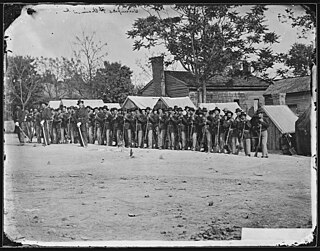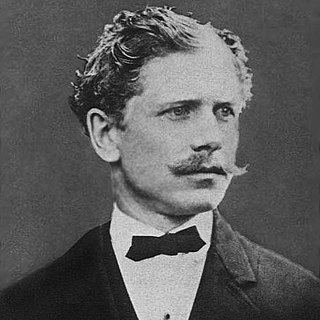Related Research Articles

The Red Badge of Courage is a war novel by American author Stephen Crane (1871–1900). Taking place during the American Civil War, the story is about a young private of the Union Army, Henry Fleming, who flees from the field of battle. Overcome with shame, he longs for a wound, a "red badge of courage", to counteract his cowardice. When his regiment once again faces the enemy, Henry acts as flag-bearer, carrying the regimental colors.

The Battle of Philippi formed part of the Western Virginia Campaign of the American Civil War and was fought in and around Philippi, Virginia, on June 3, 1861. A Union Army victory, it was the first organized land action of the war, though generally viewed as a skirmish rather than a battle.

The Battle of Resaca, from May 13 to 15, 1864, formed part of the Atlanta Campaign during the American Civil War, when a Union force under William Tecumseh Sherman engaged the Confederate Army of Tennessee led by Joseph E. Johnston. The battle was fought in Gordon and Whitfield Counties, Georgia, and is generally viewed as inconclusive.

The Battle of Camp Allegheny, also known as the Battle of Allegheny Mountain, took place on December 13, 1861, in Pocahontas County, Virginia, about 3 miles from the mountainous border of Highland County, Virginia, as part of the Operations in Western Virginia Campaign during the American Civil War. The battle was a small brigade-level conflict, and while the Confederates technically won with a Union withdrawal, it was considered militarily indecisive. However, it had critical implications for the future border of Virginia and West Virginia, ensuring Highland County remained in Confederate hands and would not be involved in the formation of the future state of West Virginia.

"An Occurrence at Owl Creek Bridge" (1890) is a short story by American writer and Civil War veteran Ambrose Bierce, described as "one of the most famous and frequently anthologized stories in American literature". It was originally published by The San Francisco Examiner on July 13, 1890, and was first collected in Bierce's book Tales of Soldiers and Civilians (1891). The story is set during the American Civil War and is known for its irregular time sequence and twist ending. Bierce's abandonment of strict linear narration in favor of the internal mind of the protagonist is an early example of the stream of consciousness narrative mode.

The Battle of Pickett's Mill was fought in Paulding County, Georgia, between Union forces under Major General William Tecumseh Sherman and Confederate forces led by General Joseph E. Johnston during the Atlanta Campaign in the American Civil War. Sherman sent Brigadier General Thomas J. Wood's division, supported by other formations, to turn Johnston's right flank, but the Federals were repulsed with heavy casualties when they ran into tenacious Confederate opposition. Author Ambrose Bierce, an eyewitness, later wrote an account of the battle titled The Crime at Pickett's Mill.

The 9th Indiana Volunteer Infantry Regiment was a volunteer infantry regiment in the Union Army during the American Civil War. It was organized on April 22, 1861, for three-months' service in Indianapolis. After being reorganized for three years' service in late August and early September 1861, the 9th took part in many major battles, including Shiloh, Stones River, Chickamauga, Lookout Mountain, Missionary Ridge, Kennesaw Mountain and the Siege of Atlanta.
"A Horseman in the Sky" is a heavily anthologized short story by American Civil War soldier, wit, and writer Ambrose Bierce. It was published on April 14, 1889 under the title The Horseman in the Sky in the Sunday edition of The Examiner, a San Francisco newspaper owned by William Randolph Hearst. It is set during the American Civil War and is one of Bierce's best known war stories. Bierce revised the story for his book Tales of Soldiers and Civilians.

Ambrose Gwinnett Bierce was an American short story writer, journalist, poet, and American Civil War veteran. His book The Devil's Dictionary was named one of "The 100 Greatest Masterpieces of American Literature" by the American Revolution Bicentennial Administration. His story "An Occurrence at Owl Creek Bridge" has been described as "one of the most famous and frequently anthologized stories in American literature", and his book Tales of Soldiers and Civilians was named by the Grolier Club one of the 100 most influential American books printed before 1900.
"The Damned Thing" is a horror short story written by American Civil War soldier, wit, and writer Ambrose Bierce. It first appeared in Town Topics on December 7, 1893.

Tales of Soldiers and Civilians is a collection of short stories by American Civil War soldier, wit, and writer Ambrose Bierce, also published under the title In the Midst of Life. With a stated publication date of 1891 the stories describe unusual incidents in the lives of soldiers and civilians during the American Civil War. Tales of Soldiers and Civilians was named by the Grolier Club as one of the 100 most influential American books printed before 1900, stating "These short stories are among the finest, and best known, in American literature. ... Written in a clear simple style, with each phrase contributing to the total effect, Bierce's tales pointed the way for the American short-story writer." Bierce's famous story "An Occurrence at Owl Creek Bridge" is included in this collection.
"The Eyes of the Panther" is a short story by American Civil War soldier, wit, and writer Ambrose Bierce featuring a female werepanther. It was published in The San Francisco Examiner on 17 October, 1897 before appearing in his 1898 collection In the Midst of Life.
"Beyond the Wall" is a ghost story by American Civil War soldier, wit, and writer Ambrose Bierce. It was published by Cosmopolitan in December 1907.
"The Boarded Window: An Incident in the Life of an Ohio Pioneer" is a short story by American Civil War soldier and writer Ambrose Bierce. It was first published in The San Francisco Examiner on April 12, 1891, and was reprinted the same year in Bierce's collection Tales of Soldiers and Civilians. The setting for the story is the part of Ohio where Bierce's family lived until 1846.
"One of Twins" is a short story by American Civil War soldier, wit, and writer Ambrose Bierce exploring a telepathic connection between the twins. It was first published in The San Francisco Examiner on October 28, 1888 and was included in Bierce's 1893 collection of supernatural tales Can Such Things Be?
"One of the Missing" is a short story by American Civil War soldier, wit, and writer Ambrose Bierce. It was first published in The San Francisco Examiner on March 11, 1888 and was reprinted in Tales of Soldiers and Civilians (1891).
"A Tough Tussle" is a short story by American Civil War soldier, wit, and writer Ambrose Bierce. It was published on the first page of the Sunday supplement to The San Francisco Examiner on September 30, 1888 and was reprinted in Tales of Soldiers and Civilians (1891).

"A Psychological Shipwreck" is a short story by American Civil War soldier, wit, and writer Ambrose Bierce and published by The Argonaut under the title "My Shipwreck" on May 24, 1879. It was included in the 1893 collection Can Such Things Be?

"The Realm of the Unreal" is a short story by American Civil War soldier, wit, and writer Ambrose Bierce. It appeared in The San Francisco Examiner on July 20, 1890 and was reprinted in the 1893 collection Can Such Things Be?

The Hazen Brigade Monument at Stones River National Battlefield, Murfreesboro, Tennessee, is the oldest American Civil War monument remaining in its original battlefield location.
References
- ↑ ""Killed at Resaca"". www.ambrosebierce.org. Retrieved Sep 20, 2019.
- ↑ Donald T. Blume. Ambrose Bierce's Civilians and Soldiers in Context: A Critical Study. Kent State University Press, 2004. ISBN 9780873387781. P. 74.